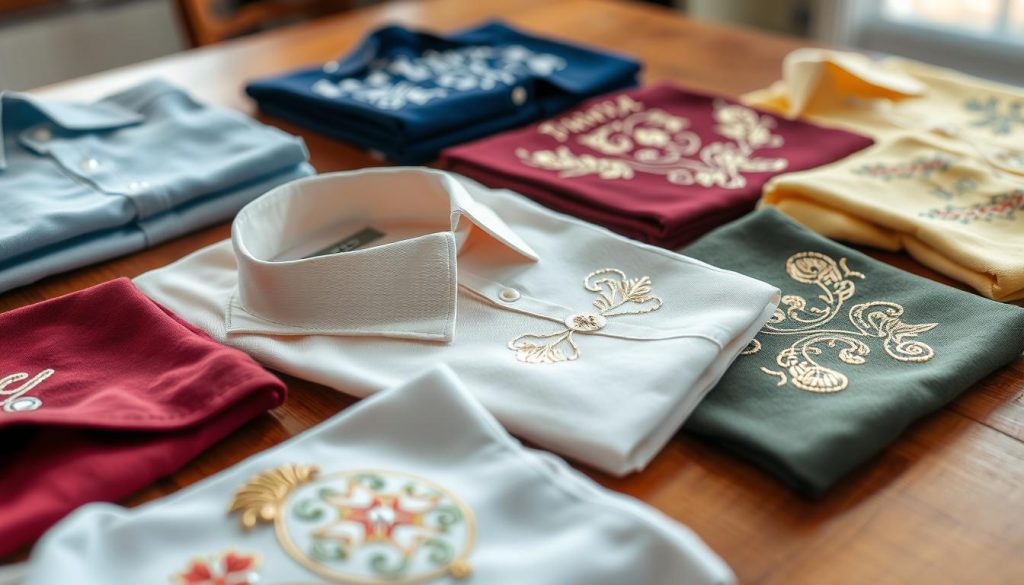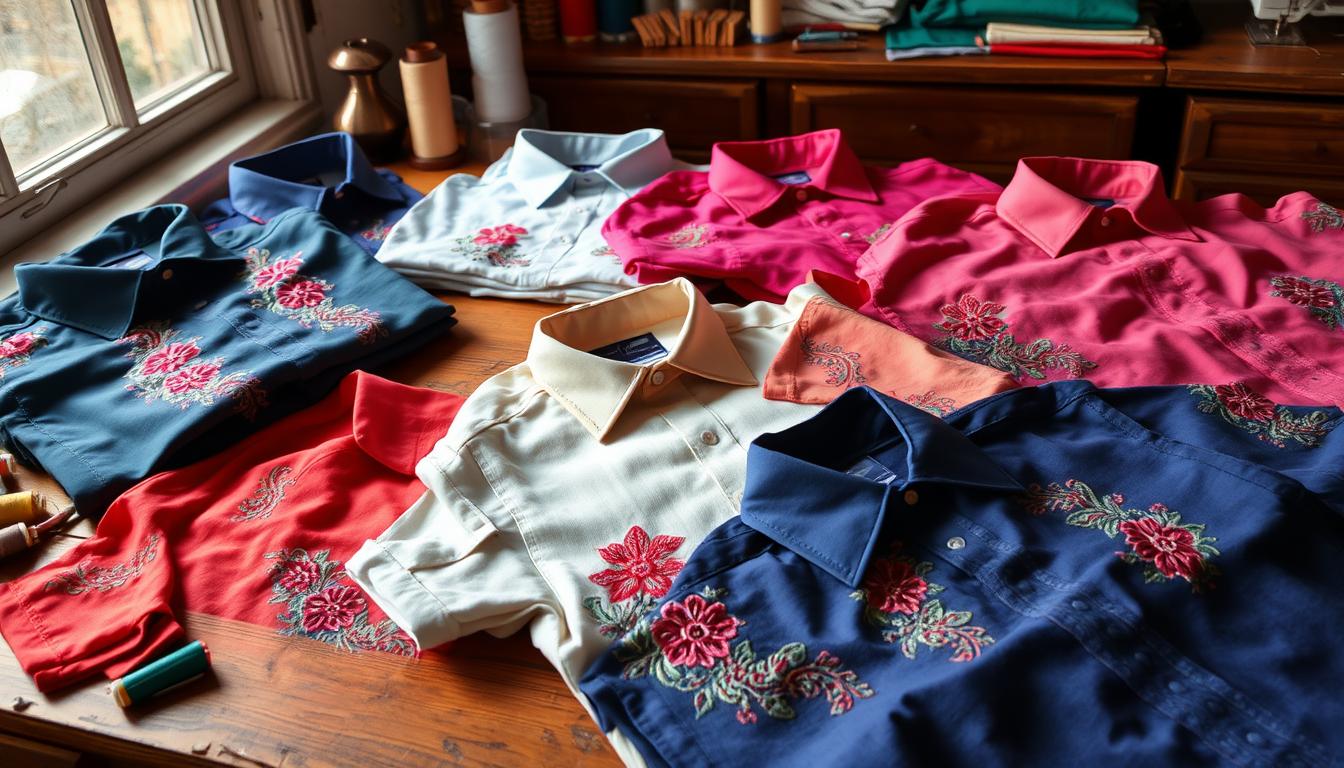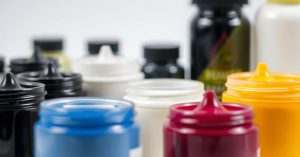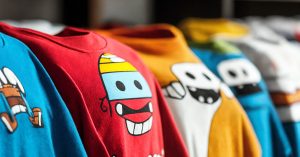Custom Embroidered Shirts: Tips, Tricks, and Things to Consider
Elevating your personal style or establishing a professional business brand becomes effortless when you invest in custom embroidered shirts that truly represent your vision. This comprehensive guide will walk you through every essential aspect of creating exceptional personalized apparel, from selecting the perfect fabrics to understanding the intricate details of design placement, ensuring that your shirts not only look professional but also stand out in any setting where you want to make a lasting impression.
Key Takeaways
- Explore different shirt materials and embroidery techniques for optimal results
- Learn how to choose the right fabric for successful embroidery
- Discover essential design guidelines for custom embroidery
- Understand the cost factors involved in custom embroidered shirts
- Ensure quality and production time when ordering custom embroidered shirts
- Maintain the longevity of your custom embroidered shirts
- Avoid common mistakes when ordering custom embroidered shirts
Table of Contents
Understanding Custom Embroidered Shirts Basics
When exploring the fascinating world of custom embroidered shirts, understanding the fundamental basics becomes essential for making informed decisions that will ultimately determine the success of your project. The material selection serves as the crucial foundation upon which your embroidery work will be built, and this choice significantly impacts both the appearance and durability of your finished product.
You have an extensive range of fabric options to consider, from luxuriously soft cotton shirts that provide comfort and breathability, to durable polyester blends that offer excellent moisture-wicking properties and color retention, or perhaps the timeless elegance of pique polo shirts that combine professional appearance with versatility. Each of these materials brings unique characteristics that serve as the perfect canvas for detailed embroidery work, and understanding their properties helps you select the ideal foundation for your specific requirements.
Common Embroidery Techniques
The world of embroidery offers numerous sophisticated techniques that can transform ordinary custom embroidered shirts into extraordinary pieces of wearable art. Flat embroidery creates a smooth, professional appearance that works exceptionally well for logos, text, and detailed designs where precision and clarity are paramount, while 3D puff embroidery adds remarkable depth and dimension to your designs, creating a raised effect that literally makes your artwork pop off the fabric surface.
The choice of embroidery thread plays an equally important role in determining the final appearance and tactile feel of your shirts, with rayon threads offering exceptional shine and vibrant colors that catch the light beautifully, while polyester threads provide superior durability and colorfastness that maintains its appearance through countless washes and years of wear.
Design Placement Options
Custom embroidered shirts provide virtually unlimited possibilities when it comes to design placement, allowing you to strategically position your artwork for maximum visual impact and brand recognition. The left chest area remains the most popular choice for small logos, monograms, or company names due to its professional appearance and high visibility during business interactions and networking events.
However, expanding your creative horizons to include sleeve embroidery or full-back designs opens up exciting opportunities to showcase more detailed artwork, larger logos, or comprehensive branding messages that command attention and create memorable impressions. Understanding these placement options and their respective advantages enables you to make strategic decisions that align with your specific goals and aesthetic preferences.

Custom Embroidered Shirts
Creating exceptional custom embroidered shirts requires a deep understanding of how various elements work together harmoniously to produce results that exceed expectations while delivering lasting value. The process involves careful consideration of multiple factors, from initial design concepts through final production, ensuring that every detail contributes to a finished product that represents your vision perfectly.
Choosing the Right Fabric for Embroidery Success
Selecting the appropriate fabric for your custom embroidered shirts represents one of the most critical decisions in the entire process, as this choice directly influences both the visual appeal of your finished embroidery and its long-term durability under regular use and care. The right fabric selection enhances the embroidery’s appearance while ensuring that your investment continues to look professional and attractive for years to come.
Several key fabric characteristics demand careful consideration, including weight, durability, breathability, and moisture-wicking properties, all of which contribute significantly to achieving exceptional embroidery results that meet or exceed your expectations. Understanding how these properties interact with different embroidery techniques helps you make informed decisions that optimize both appearance and performance.
Fabric weight plays a particularly crucial role in determining embroidery success, with thicker fabrics such as cotton canvas or heavy cotton providing excellent stability for detailed designs and intricate artwork that requires precise stitching and dimensional accuracy. These heavier fabrics also demonstrate exceptional durability, ensuring that your embroidery maintains its professional appearance even after extensive wear and numerous washing cycles.
Conversely, lighter fabrics like polyester blends or microfiber materials excel at showcasing fine details and delicate design elements while offering superior comfort and enhanced breathability that makes them ideal for active wear applications and warm weather use.
Fabric Type | Weight | Durability | Breathability | Moisture-wicking |
Cotton | Medium to Heavy | High | High | Moderate |
Polyester | Light to Medium | Moderate | Moderate | High |
Microfiber | Light | Moderate | High | High |
Canvas | Heavy | High | Moderate | Low |
The breathability and moisture-wicking properties of your chosen fabric become particularly important considerations when designing custom embroidered shirts intended for active use, outdoor environments, or situations where comfort during extended wear is essential. Fabrics like cotton and microfiber excel in these applications by promoting air circulation and effectively managing moisture, creating a comfortable wearing experience that enhances user satisfaction and encourages regular use.

Essential Design Guidelines for Custom Embroidery
Creating outstanding custom embroidered shirts requires meticulous attention to design details that ensure your finished product achieves the professional appearance and visual impact you envision. Every design element, from color selection through font choices and logo adaptation, plays a crucial role in determining the success of your embroidery project and its ability to communicate your intended message effectively.
Color Selection and Combinations
The strategic selection of thread colors represents a fundamental aspect of creating visually striking custom embroidered shirts that capture attention while maintaining professional appeal and readability in various lighting conditions. Successful color selection involves understanding how different thread colors interact with your chosen fabric color to create the desired contrast and visual hierarchy that guides the viewer’s attention to your most important design elements.
Implementing high-contrast combinations, such as using dark thread colors on light-colored shirts or light thread colors on dark fabrics, ensures maximum readability and visual impact that makes your design clearly visible from various distances and angles. Experimenting with complementary color schemes creates bold, attention-grabbing effects that work exceptionally well for promotional materials and brand recognition, while analogous color combinations produce harmonious, sophisticated appearances that convey professionalism and refined taste.
Font Styles and Sizes
Typography selection for custom embroidered shirts requires careful consideration of how different font characteristics translate into embroidered stitches while maintaining legibility and visual appeal at various sizes and viewing distances. Choosing fonts with clean, simple shapes and adequate spacing between characters ensures that your text remains clearly readable after the embroidery process, avoiding the common problem of characters becoming muddled or difficult to distinguish when converted to stitches.
The font size must strike the perfect balance between readability and design proportion, ensuring that text elements are large enough to remain legible while avoiding oversized text that dominates the design or appears unprofessional. Additionally, avoiding overly decorative or script fonts prevents details from becoming lost or distorted during the embroidery process, which can result in unclear text that fails to communicate your intended message effectively.
Logo Adaptation for Embroidery
Successfully adapting logos for custom embroidered shirts requires understanding how to modify existing artwork to work optimally with embroidery techniques while preserving the essential elements that make your logo recognizable and effective. Vector graphics provide the ideal starting point for embroidery adaptation because they maintain image quality at any size and can be easily modified to meet embroidery requirements without losing important details or clarity.
Simplifying complex design elements becomes essential for successful logo adaptation, as intricate details that work well in print or digital applications may become unclear or lost when translated into embroidered stitches. Strategic placement and sizing considerations ensure that your logo achieves maximum visual impact while working harmoniously with the shirt’s overall design aesthetic and proportions.
The Cost Factors of Custom Embroidered Shirts
Understanding the various factors that influence the pricing of custom embroidered shirts enables you to make informed decisions that balance your quality expectations with budget constraints while ensuring that your project delivers the professional results you need. Multiple elements contribute to the final cost, and recognizing how these factors interact helps you optimize your investment for maximum value and satisfaction.
Order quantity represents one of the most significant pricing factors, as purchasing larger quantities typically results in lower per-unit costs due to economies of scale that benefit both you and the embroidery provider. This pricing structure makes custom embroidered shirts particularly attractive for businesses, organizations, and groups that need multiple shirts, as the cost savings can be substantial when ordering in larger volumes.
Design complexity directly impacts pricing through the stitch count required to reproduce your artwork accurately, with more detailed designs requiring additional time and precision during the embroidery process. Simple designs with fewer colors and less intricate details generally cost less to produce, while complex logos or artwork with multiple colors and fine details require more resources and expertise, resulting in higher per-unit costs.
Fabric type and material quality also influence pricing, as premium fabrics or specialized materials may carry higher base costs or require specific embroidery techniques that add to the overall project expense. Additionally, setup fees such as design digitization and production preparation represent one-time costs that are typically amortized across your order quantity, making larger orders more cost-effective per unit.
Quality Considerations and Production Time
Achieving exceptional quality in your custom embroidered shirts requires understanding the relationship between various production factors and how they influence both the appearance and durability of your finished products. Quality considerations encompass multiple aspects of the embroidery process, from initial design preparation through final quality control measures that ensure your shirts meet professional standards.
Stitch Count and Quality
The embroidery density, measured in stitches per square inch, plays a crucial role in determining both the visual appearance and long-term durability of designs on custom embroidered shirts. Professional embroidery services typically utilize between 2,000 to 4,000 stitches per square inch to achieve optimal results that balance design clarity with fabric integrity, ensuring that your embroidered designs maintain their professional appearance through regular wear and care.
Higher stitch counts generally produce more detailed and visually appealing designs that capture fine details and create smooth color transitions, while also providing enhanced durability that resists fraying and maintains its appearance over time. Conversely, insufficient stitch density can result in designs that appear sparse or unprofessional, with visible fabric showing through the embroidery and reduced longevity under normal use conditions.
Production Timelines
Understanding typical production timelines for custom embroidered shirts helps you plan your projects effectively while setting realistic expectations for delivery dates that align with your specific needs and deadlines. Most professional embroidery services require approximately 10-14 business days from order confirmation to final delivery, though this timeframe can vary based on several factors including order size, design complexity, and current production schedules.
Larger orders or particularly complex designs may require additional production time to ensure quality standards are maintained throughout the manufacturing process, while rush orders may be available for an additional fee when circumstances require faster turnaround times.
Quality Control Measures
Reputable embroidery providers implement comprehensive quality assurance procedures to ensure that every custom embroidered shirts order meets professional standards and customer expectations. These measures typically include a detailed sample approval process where customers can review and approve their design before full production begins, allowing for any necessary adjustments or corrections to be made before the final production run.
Additionally, quality control procedures involve thorough inspection of each finished shirt to identify and correct any defects or inconsistencies, along with careful monitoring of embroidery machine settings and thread tension to maintain optimal stitch quality and consistency throughout the production process.
Maintaining Your Custom Embroidered Shirts
Proper care and maintenance of your custom embroidered shirts significantly extends their lifespan while preserving the professional appearance and vibrant colors that make them effective for personal use or business branding purposes. Implementing appropriate care techniques from the beginning ensures that your investment continues to look outstanding and represent your image positively for years to come.
Washing Instructions
Washing custom embroidered shirts requires special attention to protect the embroidered elements while maintaining the fabric’s integrity and appearance. Always use cold water for washing, as hot water can cause thread colors to fade and may damage the embroidery’s texture and appearance over time. Additionally, avoid using harsh detergents or fabric softeners that can break down embroidery threads or cause colors to bleed, instead opting for mild, gentle detergents specifically formulated for delicate fabrics.
Stain Removal
When dealing with stains on custom embroidered shirts, prompt and gentle treatment prevents permanent damage while preserving the embroidery’s appearance and integrity. Immediately blot any stains with a clean, damp cloth using gentle pressure, avoiding rubbing motions that can distort or damage the embroidered design elements. For persistent stains, use specialized stain removal products designed for delicate fabrics, always testing on an inconspicuous area first to ensure compatibility.
Ironing Tips
Proper ironing techniques for custom embroidered shirts protect the dimensional qualities of your embroidery while maintaining a crisp, professional appearance. Always iron shirts inside-out using low heat settings, and avoid pressing directly on embroidered areas where the heat and pressure can flatten or damage the raised stitching that gives embroidery its distinctive appearance and texture.
Storage Recommendations
Appropriate storage methods for custom embroidered shirts prevent wrinkles, maintain shape, and protect embroidered elements from damage during periods of non-use. Use sturdy, padded hangers that support the shirt’s natural shape without creating stress points or distortion, and store shirts in cool, dry environments away from direct sunlight that can cause color fading over time.
Maintenance Tip | Rationale |
Use gentle, cold-water washing | Protects the embroidered design from damage |
Blot stains, don’t rub | Prevents distortion of the embroidery |
Iron shirts inside-out on low heat | Prevents flattening or damage to the embroidery |
Store on padded hangers in a cool, dry place | Maintains the shape and color of the embroidery |
Common Mistakes to Avoid When Ordering Custom Embroidered Shirts
Successfully ordering custom embroidered shirts requires awareness of common pitfalls that can compromise your project’s success, from initial planning through final delivery. Understanding and actively avoiding these mistakes ensures order accuracy, streamlines the production process, and results in finished products that meet or exceed your expectations while delivering the professional appearance you need.
Size and Quantity Errors
Accurate sizing and quantity planning represents one of the most critical aspects of ordering custom embroidered shirts successfully, as errors in these areas can result in significant delays, additional costs, and products that don’t meet your actual needs. Take time to carefully measure all recipients and consult detailed size charts provided by your embroidery supplier, as sizing can vary between different brands and fabric types.
Additionally, calculate your quantity requirements carefully, accounting for potential size exchanges, future needs, and any promotional or backup purposes you might have for extra shirts. Ordering slightly more than your immediate needs often proves cost-effective due to quantity discounts and eliminates the need for future minimum-order requirements for small reorders.
Design Format Issues
Proper file preparation plays a crucial role in achieving professional results with custom embroidered shirts, and providing your embroidery supplier with appropriate file formats prevents delays and ensures optimal design reproduction. Supply high-resolution, vector-based designs whenever possible, as these formats maintain quality at any size and provide the clean lines necessary for precise embroidery reproduction.
Avoid submitting raster images or low-resolution files that can result in pixelated or unclear embroidery, and maintain open communication with your supplier regarding any special requirements such as specific stitch counts, design dimensions, or color matching needs during the proofing and approval process.
Material Mismatches
Selecting appropriate fabric types for your specific embroidery requirements prevents production issues and ensures optimal results with your custom embroidered shirts. Different fabric types require specific needles, thread types, and machine tension settings to achieve professional results, making it essential to work closely with your embroidery supplier to ensure compatibility between your chosen fabric and intended design complexity.
Discuss your specific requirements and intended use for the shirts with your supplier, allowing them to recommend fabric options that work optimally with your design while meeting your performance and aesthetic expectations.
Your Journey to Perfect Custom Embroidered Shirts
Throughout this comprehensive exploration of custom embroidered shirts, we’ve covered the essential elements that contribute to successful projects, from understanding fabric fundamentals and embroidery techniques through design guidelines, cost considerations, and quality maintenance practices. This knowledge foundation empowers you to make informed decisions that result in exceptional custom apparel that serves your specific needs effectively.
Custom embroidered shirts offer tremendous potential for enhancing brand visibility, creating team unity, and projecting a professional image that makes lasting impressions in both personal and business contexts. Whether you’re developing a personal style statement or establishing a cohesive business brand identity, these versatile garments provide an excellent platform for showcasing your unique vision and values.
Armed with this comprehensive understanding of custom apparel principles, you’re now prepared to embark on your embroidery journey with confidence, making strategic decisions about fabric selection, design elements, and production details that maximize the impact and longevity of your investment. Let your distinctive style and professional image shine through exceptional custom embroidered shirts that truly represent who you are and what you stand for.





